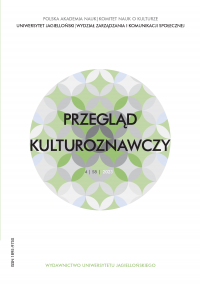BEZPAŃSKA BIOPOLITYKA – MASZYNA ZOOLOGICZNA, ZDZICZAŁE EKOLOGIE I POLITYCZNE POTENCJAŁY ZWIERZĘCEGO UWSPóLNIANIA
THE STRAY BIOPOLITICS – THE ZOOLOGICAL MACHINE, FERAL ECOLOGIES AND THE POLITICAL POTEN- TIALS OF ANIMAL COMMONING
Author(s): Piotr JuskowiakSubject(s): Rural and urban sociology, Environmental interactions
Published by: Wydawnictwo Uniwersytetu Jagiellońskiego
Keywords: biopolitics; stray dogs; zoological machine; ferality; caninecide; dogopolis; commoning; neighbor;
Summary/Abstract: The article seeks to develop an alternative model of biopolitics based on the experience of stray dogs in the context of the transformation of the modern urban fabric. Its main goal is to show, on the one hand, that the purificatory actions of biopower in the context of street-dwelling dogs were an inalienable condition of modern urbanization in the West Atlantic variant, which made one of its pillars the multi-scalar process of spatial segregation of nonhuman animals. On the other, to offer such a look at strayness that, by violating the modern zoological machine and disarming the urban fear of animal collectivity, would open urban politics and urbanization to new possibilities emerging from the experience of the multispecies crowd. Another important task of the article will be to rethink the ontological status of stray dogs, which elude most, essentially biopo- litical classifications of urban animals, revealing the political potential of the category of ferality.The article consists of five parts. In the first, I refer to existing accounts of animal biopolitics, noting their merits and the main limitation, namely, the lack of in-depth reflection on such a politics of life that would take into account the autonomy and agency of animal subjects. In the second, I develop the notion of the zoological machine (with reference to Agamben’s philosophy), having in mind the semiotic-material apparatuses responsible for the production and maintenance of species differences, as well as the concealment of related violence. The third part serves to show its work- ings through the example of stray dogs in Victorian cities. My focus here – following Chris Pearson – is to show the interdependent processes of canine killing and the emergence of dogopolis (i.e., new, typically Western dog-human relationships), which turn out to be a key component of modern urbanization. In part four, I analyze the potentials of “ferality”, seeing it as a field of opportunity for alternative interspecies practices that hold the promise of disarming the Western zoological ma- chine. The fifth part and the conclusion serve to present two key cases (Moscow and Chernobyl), against the background of which I develop the aforementioned biopolitical alternative. In doing so, I use such concepts as commoning, inhabitation, and the figure of the neighbor.
Journal: Przegląd Kulturoznawczy
- Issue Year: 58/2023
- Issue No: 4
- Page Range: 475-502
- Page Count: 28
- Language: Polish

